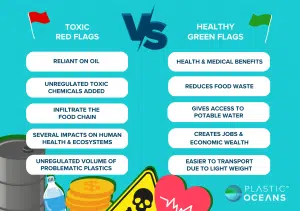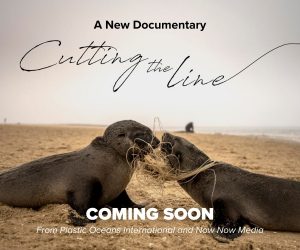In honor of the month of February, I’ve just changed my relationship status with plastics to, “it’s complicated”. It’s the best I’ve felt about plastics in a long time. Here’s why.
We must be willing to accept that not everything is black or white, good or bad, right or wrong. Quite a bit of grey area exists within many of these more complex situations, and you know why? Because it’s extremely complex.
If time is spent walking around a hospital, looking around a plane, or investigating how our electronics work, it’s easy to see why we need plastics. The material is flexible, inexpensive, durable and can handle varying temperatures well1,2. Plastic also helps to reduce food waste3, which ties in directly to improving climate change and biodiversity4,5. That’s a big deal. Plastic is also extremely lightweight. Its usage leads to better emissions6 and improved fuel consumption, especially in comparison to other materials such as metal or glass. From a medical perspective, plastic is invaluable. This was particularly apparent during the COVID-19 pandemic in which the use of plastic helped curb the spread of the virus substantially, saving countless lives7.
Okay cool, plastic is good. Phew.
Wait.
The sheer amount of plastic used by humans makes it an immediate threat to the planet. Most waste infrastructure systems are unable to handle the volume of plastic sent their way. There are also seemingly endless inputs of plastic waste into our environment, where many negative impacts have been documented8. From larger plastics causing mortality in a range of animal species9 to micro- and nanoplastics disrupting normal body processes and causing harm to various bodily systems10, growing evidence is demonstrating the negative impacts of plastic pollution. The overall disturbance of ecosystem services has also been demonstrated in locations all over the world11.
Wow, okay. Plastic is definitely bad. Let’s ban it.
Hold on.
In many communities, plastics have been banned in certain capacities, but that’s not always the best path forward. Plastic bag bans, for example, have grown in popularity. This relies on consumers utilizing reusable bags. Researchers have demonstrated reusable bags to pose a risk to health via microbial contamination7. In other studies, reusable bags were tested for the presence of fecal bacteria and 99% of the bags tested were found to contain contamination7.
Washing your bags can help, but with only around 3% of the population doing that, is it worth discussing? This is all in addition to the actual environmental impact of using reusable bags. To reach the lower environmental impact of single use bags, an organic cotton reusable bag must be used nearly 20,000 times7 while a paper bag must be used 43 times12. Cotton requires more energy and water to be produced while paper bags take four times more energy in addition to generating higher levels of air or water pollutants relative to plastic bags13. Other replacements, such as glass or bamboo have their own separate sets of impacts. Some argue that LCAs don’t represent all of the most relevant information, but these factors should still be considered.

Our Relationship with Plastics: Toxic Red Flags vs Healthy Green Flags
I know that’s a lot to lay on you and my point here isn’t to be deflating or a downer. I just want to cut you off a slice of the gray area cake that we end up having to swallow daily. Complicated problems require complicated solutions, and that’s okay. In the meantime, we can both appreciate that plastics do for us but also push for a world with zero plastic waste and more sustainable options. As stated by the International Union for Conservation of Nature (IUCN), if we can continue to improve recycling/reuse strategies and continue to support innovations in material science, we can greatly prevent and reduce plastic pollution.
For now, our relationship with plastic is complicated. And that’s okay.
References:
- d’Ambrières & Woldemar. Plastics recycling worldwide: current overview and desirable changes. http://journals.openedition.org/factsreports 12–21 (2019).
- Agarwal, S. & Gupta, R. K. Plastics in Buildings and Construction. Applied Plastics Engineering Handbook: Processing, Materials, and Applications: Second Edition 635–649 (2017) https://doi.org/10.1016/B978-0-323-39040-8.00030-4.
- Raheem, D. APPLICATION OF PLASTICS AND PAPER AS FOOD PACKAGING MATERIALS – AN OVERVIEW. Emir J Food Agric 25, 177–188 (2013).
- Abeliotis, K., Lasaridi, K., Costarelli, V. & Chroni, C. The implications of food waste generation on climate change: The case of Greece Article in Sustainable Production and Consumption · REWEEE (Reuse of WEEE) View project Stress Management and Health Promotion View project. (2015) https://doi.org/10.1016/j.spc.2015.06.006.
- Feldstein, S. Wasting biodiversity: why food waste needs to be a conservation priority. https://doi.org/10.1080/14888386.2017.1351891 18, 75–77 (2017).
- Andrady, A. L. & Neal, M. A. Applications and societal benefits of plastics. https://doi.org/10.1098/rstb.2008.0304.
- Danielli, F. & de Sousa, B. Pros and Cons of Plastic during the COVID-19 Pandemic. https://doi.org/10.3390/recycling5040027.
- Zhang, H. Characteristics of Plastic Pollution in the Environment: A Review. Article in Bulletin of Environmental Contamination and Toxicology (2021) https://doi.org/10.1007/s00128-020-02820-1.
- Roman, L., Schuyler, Q., Wilcox, C. & Hardesty, B. D. Plastic pollution is killing marine megafauna, but how do we prioritize policies to reduce mortality? Conserv Lett 14, e12781 (2021).
- Prüst, M., Meijer, J. & Westerink, R. H. S. The plastic brain: neurotoxicity of micro- and nanoplastics. Particle and Fibre Toxicology 2020 17:1 17, 1–16 (2020).
- Kumar, R. et al. Impacts of Plastic Pollution on Ecosystem Services, Sustainable Development Goals, and Need to Focus on Circular Economy and Policy Interventions. Sustainability 2021, Vol. 13, Page 9963 13, 9963 (2021).
- valenb & envdtudk. Life Cycle Assessment of grocery carrier bags. (2018).
- Bell, K. & Cave, S. Comparison of Environmental Impact of Plastic, Paper and Cloth Bags. (2011).
Dr. Charlie Rolsky is the Director of Science for Plastic Oceans International. He is also the host of Breaking It Down, With Charlie Rolsky – a YouTube series from Plastic Oceans that simplifies the science, while having a bit of fun. He is the Senior Research Scientist at the Shaw Institute in Maine, where he works on linking environmental health to human health through scientific research and outreach

